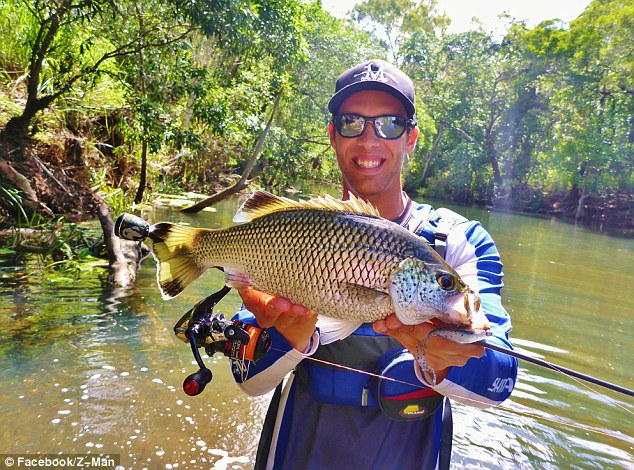
Kuhlia rupestris
FAMILY
Kuhliidae
TAXONOMY
Kuhlia rupestris Lacepиde, 1802, Gol Ravine, Reunion Island,
Indian Ocean.
OTHER COMMON NAMES
English: Freshwater aholehole, freshwater kuhlia, rock flagtail;
French: Crocro sauvage; German: Felsen-Flaggenbarsch.
PHYSICAL CHARACTERISTICS
Total length 17.7 in (45 cm), but fishes in upper reaches of
freshwater streams are much smaller. Body elongate and robust
compared to others in this
FAMILY
. Mouth is relatively large,
caudal fin slightly emarginate. Color silvery or light gray with
black scale margins, becomes very silvery in marine waters.
Caudal fin is either black or clear,with black blotches on each
caudal lobe. There are 10 spines and 11 soft rays in the dorsal
fin, 3 spines and 9–10 soft rays in the anal fin, and 13–14 soft
rays in the pectoral fin.
DISTRIBUTION
Indo-West Pacific, from East Africa east to the Ryukyu, Ogasawara,
and Mariana Islands, south and east through Micronesia,
Melanesia, and Polynesia on islands with freshwater
streams; also to Australia as far south as Fraser Island.
HABITAT
Freshwater streams in coastal drainages, usually in clear waters.
Also in estuaries and coastal waters seasonally.
BEHAVIOR
Solitary or in small groups in fresh water. Somewhat cryptic in
areas with overhanging brush, undercut banks, or other forms
of structure.
FEEDING ECOLOGY AND DIET
Omnivorous, feeds upon small fishes, insects, crustaceans, and
fruit that falls on the water.
REPRODUCTIVE BIOLOGY
Catadromous, migrates to estuaries on nearshore waters to
breed.
BEHAVIOR
not well known. Courtship and spawning
might be in schools or aggregations. Eggs and larvae are
pelagic. Post-larvae migrate upstream.
CONSERVATION STATUS
Not listed by the IUCN, but insular populations vulnerable to
HABITAT
destruction and overfishing.
SIGNIFICANCE TO HUMANS
Subsistence food fish, may also be taken in minor commercial
fisheries. An important freshwater game fish in Australia and
esteemed as table fare.
Other popular Animals
Photo Gallery of - Jungle perch





 Animalia Life
Animalia Life